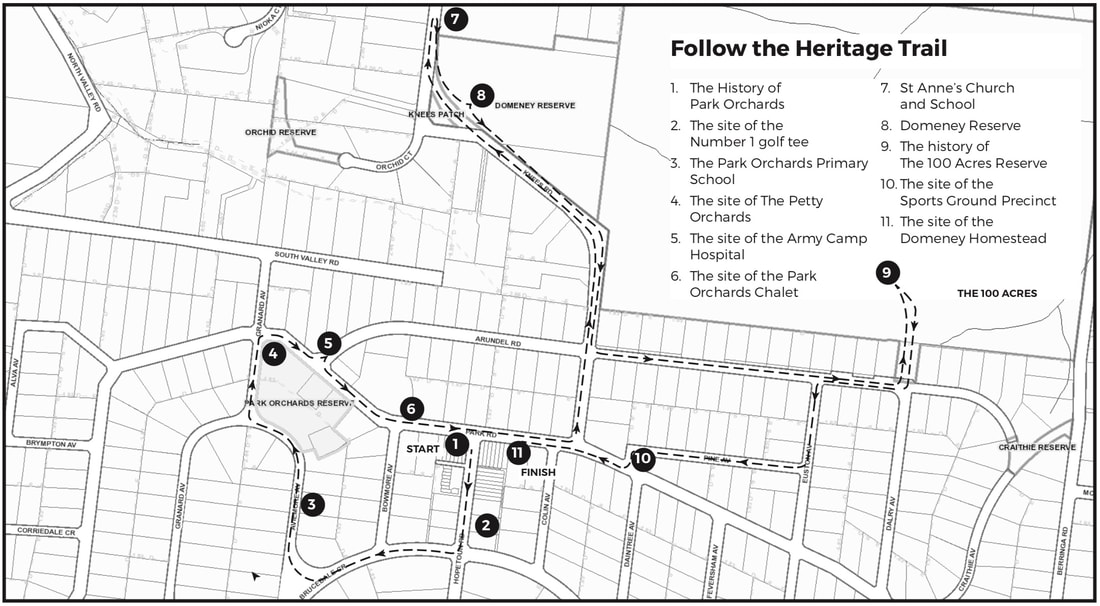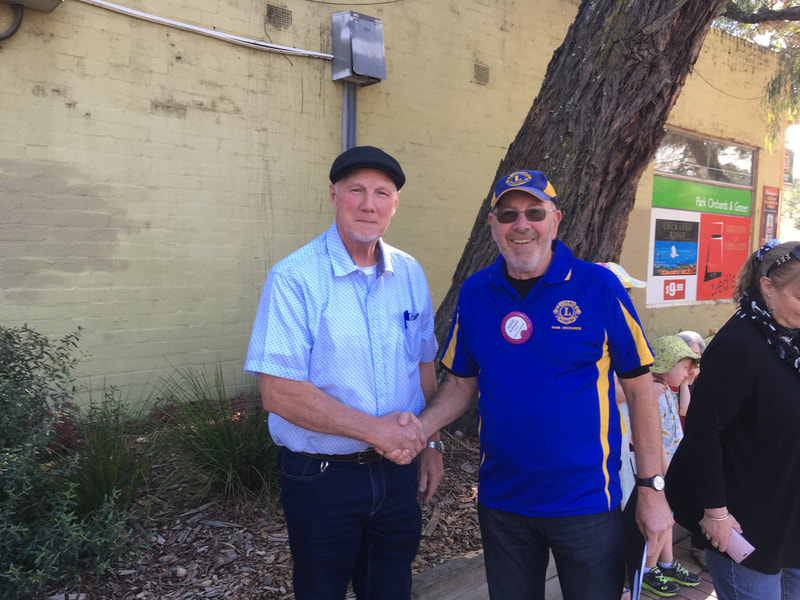Park Orchards Heritage Trail
On Sunday 19th May 2019, the Park Orchards Heritage Trail was opened by the Mayor of Manningham, Paula Piccinini. The development of the Heritage Trail is an initiative of the Park Orchards Lions and is a gift to the community in recognition of the club's 40 year anniversary along with the 100 years of Lions internationally.
|
In the early 1800s, only occasional herds of grazing cattle moved through the virgin bushland that was to become Park Orchards. The hills were heavily timbered with wattle, stringybark, box, messmate and peppermint gums. Open areas held patches of grass in which wild flowers and native orchids grew. Kangaroos and wallabies wore tracks through the bush. Echidnas and wombats hid in
the undergrowth. Silver possums swung among the trees and bandicoots were seen by keen-eyed bushmen. It was splendid country and in the 1870s became known as The Park.
All of Park Orchards rests on two Crown Allotments purchased by Francis McDonnell in 1874 and Charles Heape in 1875. Three of the earliest settlers in the area – Thomas Stinton, Euphemie Falconer and William Harris – bought nearby land in sections of one square mile for the price of £1 per acre. They were followed by Tom and Eliza Petty who purchased 559 acres in 1902. |
The Park Orchards Chalet |
In 1926, the Park Orchards Country
Club Estate was designed by
licensed surveyor and pioneer town
planner, Saxil Tuxen and his partner, George Miller. Both men had worked previously with well-known landscape architect Walter Burley Griffin. The clients were timber merchants and developers Australis Sharp and John Taylor, with land owners, sisters, Eva, Jane and Minnie Gibb. The Gibbs, along with William Sell, purchased their 559 acres from Eliza Petty of the prominent Doncaster orcharding family.
|
The Park Orchards Country Club Estate was an imaginative and ambitious scheme where purchasers of the 650 half-acre blocks would become members of the country club. They would then enjoy access to open air sporting facilities, including golf links, tennis courts, a swimming pool, oval and clubhouse. The idea was to create a family playground where life would
be “healthy, pleasurable and worth living.” Sadly, the Depression of 1930 meant few blocks were sold and the estate never reached its potential.
Park Orchards remains one of the most uniquely planned suburbs in Australia and is the finest surviving example of Tuxen’s work. It includes graceful sweeping curved roads; extensive park space and open areas; the use of Park Road as the “backbone” of the estate; and Tuxen’s trademark feature, concentric circles – in this case surrounding a large hill – creating attractive views from all points of Dirlton Reserve.
The estate was subdivided into large blocks so houses could be set amongst trees and shrubs. In the gardens of Park Orchards today, many of Tom Petty’s original fruit trees continue to grow and there are radiata pines in abundance, relics of Australis Sharp and John Taylor’s pine plantations.
In addition to the beauty of its natural bushland, Park Orchards has always maintained a strong community spirit. Local residents can take credit for many noteworthy achievements that make the town special through their work with the Park Orchards Ratepayers Association – whose goal was to maintain the picturesque character of the district, act as a catalyst for improvement and as a watchdog for unwanted development.
When Australis Sharp planned the estate in 1926, he said: “To owners of motor cars and vehicles, Park Orchards opens up a new vista in life where the work-a-day world can be most speedily changed to an environment of healthy and pleasurable associations.”
The quality of life he envisaged is still enjoyed in Park Orchards today.
Park Orchards remains one of the most uniquely planned suburbs in Australia and is the finest surviving example of Tuxen’s work. It includes graceful sweeping curved roads; extensive park space and open areas; the use of Park Road as the “backbone” of the estate; and Tuxen’s trademark feature, concentric circles – in this case surrounding a large hill – creating attractive views from all points of Dirlton Reserve.
The estate was subdivided into large blocks so houses could be set amongst trees and shrubs. In the gardens of Park Orchards today, many of Tom Petty’s original fruit trees continue to grow and there are radiata pines in abundance, relics of Australis Sharp and John Taylor’s pine plantations.
In addition to the beauty of its natural bushland, Park Orchards has always maintained a strong community spirit. Local residents can take credit for many noteworthy achievements that make the town special through their work with the Park Orchards Ratepayers Association – whose goal was to maintain the picturesque character of the district, act as a catalyst for improvement and as a watchdog for unwanted development.
When Australis Sharp planned the estate in 1926, he said: “To owners of motor cars and vehicles, Park Orchards opens up a new vista in life where the work-a-day world can be most speedily changed to an environment of healthy and pleasurable associations.”
The quality of life he envisaged is still enjoyed in Park Orchards today.
Heritage Trail Map

The Lions Club of Park Orchards thanks the Manningham Council for their support, guidance and financial contribution towards the development of the Heritage Trail. The club is also grateful to Lions International for their financial support that contributed to the success of the project.
A print friendly version of the above information is available at the following link.








